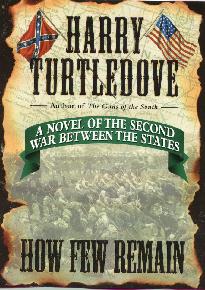

HOW FEW REMAINby Harry TurtledoveDel Rey0-345-41661-9480pp/$25.00/October 1997 |
 |
There seems to have been a lot of confusion surrounding Harry Turtledove's novel, How Few Remain. Because it has an alternate Civil War as its background, many have speculated it is a sequel to his earlier Guns of the South. This speculation was fueled by an erroneous entry in Books-in-Print which listed the title of the book as Guns of the West. Similarly, How Few Remain has been linked to Turtledove's forthcoming "The Great War" series. Although it is set in the same universe as the upcoming series, it is a prelude to it and can be read, according to Turtledove, as a stand-alone novel, or in anticipation of the series.Set in a divided North America in 1881, the Confederate States have been a separate country since Lee's victory in 1862. Unlike our world in which Lee's Special Orders 191 were lost, these orders remained secret until put into effect permitting the Confederacy to claim their independance. Much of the opening of the novel is spent explaining the details of this new world. Unfortunately, Turtledove has his characters spending way too much time going over their recent history to make their conversations seem real. Although the War of Succession was a major turning point for both countries, all the characters seem fixated on the events of the war, as if a modern person would refer to the Viet Nam war in nearly every conversation. Fortunately, this sort of dialogue mostly disappears after Turtledove defines the situation in the first fifty pages.Although Turtledove attempts to portray the United States as a stronger country than the Confederate States, he consistently demonstrates that the Confederate States are in a stronger position. Although they may have a small population base, they have more and greater allies than the United States. The Confederate States' major weakness seems to be their continued reliance on slave labor, which may affect their relationship with allied nations England and France. Even as his characters are convinced that the United States are stronger than the Confederate States, the reader becomes convinced they are wrong.As is typical of Turtledove's alternate history novels, How Few Remain sports a large cast of historical characters. For his viewpoint characters, Turtledove makes use of Abe Lincoln, Sam Clemens, J.E.B. Stuart, Theodore Roosevelt, George A. Custer, Alfred von Schlieffen, Frederick Douglass and Stonewall Jackson. This broad cast of characters allows Turtledove to present several different viewpoints of the situation and add depth to the world he has created without seeming to give any single individual an unreasonably open or broad mind. This method also makes it easier for Turtledove to avoid portraying his world in simplistic black and white terms, as too much speculative fiction still does.For the most part, Turtledove handles his cast well. Samuel Clemens sounds very realistic and Mark Twain's voice keeps peeping through despite the fact that Turtledove wrote his entire part. Similarly, Turtledove's use of Abraham Lincoln's authentic speeches give the former president the sound of realism, although the politics he espouses may surprise many people.In fact, Turtledove's portrayal of the Republican party as an whole will seem odd to anyone without some knowledge of American political party history. The 1880's, Republican Party Lincoln is a member of is more akin to the modern Democratic party than the party of Newt Gingrich and Bob Dole. Similarly, Turtledove drops hints about the Democratic Party's agenda which are not in line with what that party has become in our own world.It has been said that generals begin each war by fighting the previous war. In How Few Remain, Turtledove allows the generals of the North and the South to fight the trench warfare of World War I, albeit in a Louisville, Kentucky (destroyed as thoroughly as Turtledove had destroyed Chicago in the "Worldwar" series) rather than on the fields of France and Belgium. By providing European observers, in the form of von Schlieffen and others, Turtledove is making sure that the Europeans have knowledge of the new warfare before enterring into their own conflict. Whether or not the Europeans (or Americans) learn from these experiences will have to wait until Turtledove's related "The Great War" series debuts in the Summer of 1998. Indications show that many military minds in Turtledove's world remain slow to adapt to change even when they witness the benefits first-hand. In How Few Remain, Colonel George Armstrong Custer refuses to see the gatling gun as more than an interesting toy even though his regiment uses the weapons extremely effectively against Indians, Mormons and British.The changes in the relationship between the United States and the Confederate States throughout the course of the novel are subtle and serve to set the stage for the ongoing saga which Turtledove will write in The Great War: American Front. He has stated that Roosevelt and Custer will both play roles in the later series showing the continued growth of their relationship which began on the Montana plains in 1881. Given their ages, it is most unlikely that very many other characters will play a role when the next series begins thirty-three years later.Nevertheless, while How Few Remain can be read on its own, it leaves the reader with the feeling that there is more to come. Still, it is nice to see Turtledove tackle an alternate history in which no deus ex machina in the form of aliens or time travelers play a role. Based on the situations set forth in How Few Remain, "The Great War" should be a series to watch for.


| Return to |